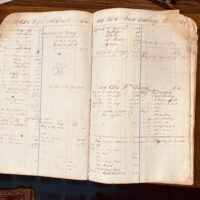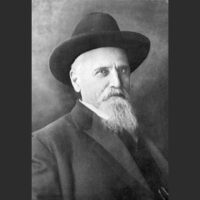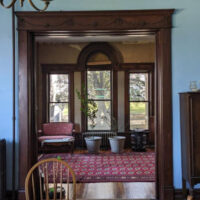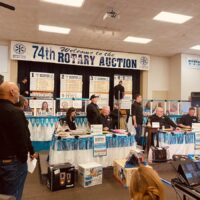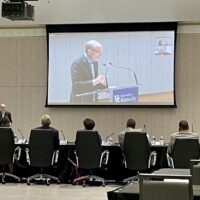Made of a rich purple velvet, this gorgeous piece is decorated with metallic threads, satins and shiny stones. A crown, stones representing the Ten Commandments, two lions, and a vase of vines and one flower adorn in elaborate needlepoint. Hebrew words are embroidered on each side of the crown. The artifact measures approximately 16 inches wide and 28 inches long — not including the gold fringe that hangs from the bottom and along its sides.
This stunning artifact is a Torah mantle that was used in Hopkinsville’s Jewish synagogue.
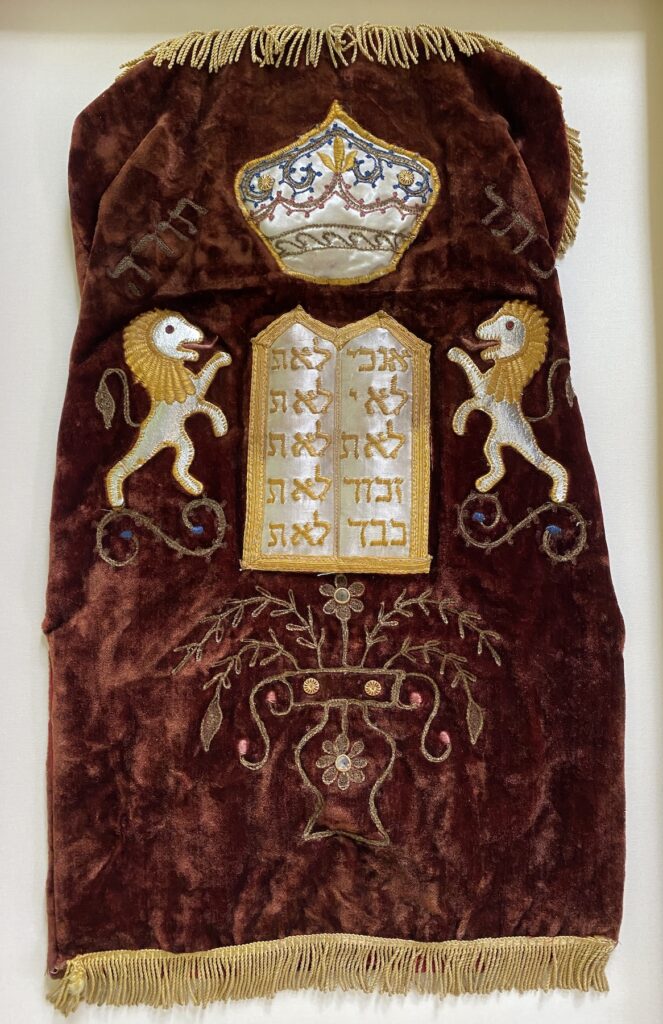
Learning that Hopkinsville had a synagogue and a thriving Jewish community was one of the more surprising stories of local history for me. By the time I was growing up here in the 1980s and ’90s, the local Jewish population — who had made their home here in the late 19th and early 20th centuries — had largely moved away. This diversity of faith was not something I had ever considered as a piece of our community’s greater story.
Boy, was I wrong.
A simple walk through downtown should have provided me with enough clues to indicate that a Jewish community had once thrived here. Names of families who gained wealth and prominence adorn the top of numerous buildings. I guess I never stopped to think about who the Kleins, Bohns, and Moayons were. The name Dan Metzler was recently uncovered when part of the facade of the Boyd’s Bridal building was removed on Main Street. These names provide a physical reminder of our Jewish heritage — and a great starting point for me to learn more.
I spent some time scanning census records and newspapers to see what I could learn about the early origins of Hopkinsville’s Jewish community. Each year of the census gives slightly different information, but the census consistently lists each person’s birthplace and the birthplace of their parents. I started in 1850, and I made note of anyone living in Christian County who was born in Germany, Poland or Russia. Being born in these countries didn’t mean that someone was Jewish, but it increased the likelihood that these immigrants to our community may have been.
The first Jewish immigrants recorded in this community arrived here before 1850. In the 1850 census, fourteen German immigrants called Christian County home. There were two merchants, a peddler, a baker, a butcher, a bricklayer, a teacher, and a music teacher. Of these, we find Bernhard Oppenheimer and his wife Babet. At the age of 39, Bernhard was listed as a merchant born in Germania. Babet’s birthplace was listed as France, and at the time, they didn’t have any children. The couple would have at least one daughter — Rebecca — who died in 1854 when she was 10 months old. Little Rebecca is the oldest recorded burial in Hopkinsville’s Jewish cemetery.
Let’s take a minute with that one. Not only did Hopkinsville have a Jewish synagogue, but it also has a Jewish cemetery. The cemetery, known as the Jewish Cemetery, Jewish Elb Cemetery (for the Elb family who purchased the land), and as Cedar Grove Cemetery in some records, serves as the sacred resting place for almost 40 people. Rebecca’s burial in 1854 is the first; Jake Myers was the last in 1947. The cemetery is located on truncated Hope Street off Ninth Street on the left as you take the curve from Belmont hill. It is a solemn site that is now under the management and care of the city of Hopkinsville.

The Find a Grave website provided more information on the Oppenheimers. Bernhard died in 1857, and his widow Babet married Louis Elb. By 1860, the Elbs, their two children, and two boarders — both working as clerks — were established in Hopkinsville. Louis Elb, like Oppenheimer, was a merchant who became a leader of the community. When Babet died in 1880, the newspaper published a lengthy obituary about her arrival in Hopkinsville, the death of her first husband, and her “rare business qualities.” She was described as “the oldest Jewish citizen in this city” who was kind, charitable, and lived up to the highest standards of excellence. When her husband died in 1884, the Odd Fellows honored him with Resolutions of Respect and wore their usual badge of mourning for 30 days.
People of the Jewish faith lived in Hopkinsville for more than 75 years before a synagogue was constructed for their services. Between 1848 and 1925 when the synagogue was dedicated, the Jewish community had grown to approximately 100 people representing 25 families. Fun fact: the Hotel Latham opened on Virginia Street on Jan. 3, 1895. Following its initial grand ball, the first major event held in the hotel was a Jewish wedding between Lula Hart, of Hopkinsville, and Max Lowenthal, of Nashville, Tennessee. A portion of the ceremony was conducted in Hebrew.
Yet another Jewish wedding in 1906 provides more information about how Jewish people lived and worshiped here. This wedding joined together Flora Bohn and Hyman Franklin, both relatives of Henry Bohn. Born in 1856 at Lozboy, Poland, Henry Bohn immigrated to the United States — first living in Louisville and then in Hopkinsville by 1889. His wife and daughter joined him here. By the time of the Bohn-Franklin wedding in 1906, Mr. Bohn was serving as the rabbi for this community. As the officiating rabbi, Bohn performed the ceremony in Hebrew while Samuel Klein provided the English translation.
Bohn, who operated a store first on Main Street and later on Sixth Street in a building that still bears his name, hosted religious services in a room of his home while he was alive. He died in 1923 and left a bequest of $5,000 for the construction of a synagogue in Hopkinsville. Sam Klein and Wolf Geller, also Jewish merchants, underwrote the remainder of the cost. Temple Adath Israel was dedicated on Feb. 24, 1925 on Sixth Street between Liberty and Clay streets. Designed by John T. Waller, the building was reminiscent of the architectural style of the Carnegie Library just a couple of blocks away.
Which brings me back to our featured artifact. This Torah cover, or mantle, was used in this local house of worship. Torah mantles are highly ornate cloth covers that are used to decorate and protect Torah scrolls. This one was recently donated to the Pennyroyal Area Museum by a member of the Bohn family. This artifact joins a small collection of other items that were once used in our synagogue. When the museum was established in 1975, the local Jewish population had decreased to the point that the synagogue was no longer being used. Members of the congregation loaned a number of precious items to the museum that we maintain in our collection today.
We are so thankful that these items came to us in our early days — both because they help us to tell a significant story and because it protected them. On Nov. 5, 1977, the roof of the synagogue collapsed under the weight of a heavy rain. The building hadn’t been used since the Jewish holidays the previous fall and only sparingly for a number of years. It was believed that a heavy snow that winter weakened the structure, and a heavy rain finally brought the whole building tumbling down.
The artifacts that survive allow us to remember and to reflect about our shared stories using tangible — and, in this case, exquisite — items. They help us tell the stories of all those who have called Hopkinsville home. They remind us to look up and to wonder about the names on our buildings. But more than anything, they encourage us to embrace our community and its history in all of its diversity and beauty.
If I learned anything while researching for this article, it was that there is still so much more to know and share about our Jewish friends here. Brett Pritchett, the museum’s new Learning Coordinator, will expand more on these stories at our next History on Tap at 6:30 p.m. Thursday, June 29, at Hopkinsville Brewing Co.
